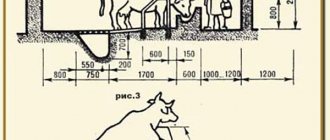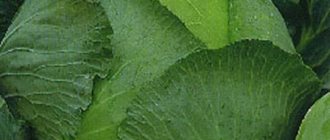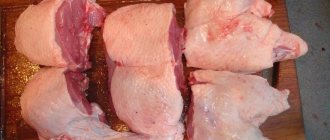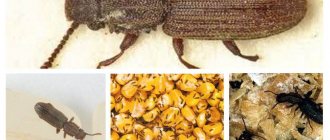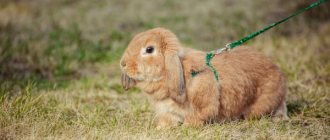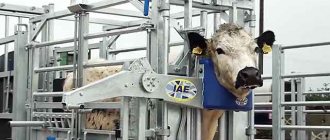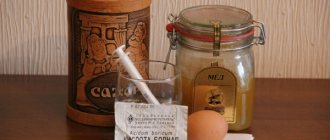When constructing cowsheds on livestock complexes, the location of the farm from residential buildings, the terrain, the wind rose, the distance to sources of drinking water, highways and country roads are taken into account. Large pens are built for large numbers of cattle.
On private farms, a place for a stall is chosen on a personal plot. They make a separate room or make an extension to the house. When building a stable on a farmstead, it is necessary to take into account the number of livestock.
Bulls require more space than cows. Separate nurseries or houses are built for calves. How to build a corral for cows on a private small farm with your own hands?
Requirements for building a stall
Dimensions
When determining the overall dimensions of the barn, the following standards are used:
- floor area per cow 6 sq.m.,
- for a cow and one calf at least 10 sq.m.,
- the width of the passage for maintenance should be 1.2-1.5 m,
- height – 2.5 m.
Drawing:
Cow stall dimensions
Modern stalls with a length of 1.7 m and a width of 1.1 m for cows should not be adjacent to the outer wall with the feeder. When animals breathe, they produce a lot of moisture, which is absorbed into the walls, forming condensation and causing dampness.
Be sure to equip a feeding passage - access to the feeders from the front. Its width with single-row stalls is 1 m. If a cage for a newborn calf is placed opposite the feeder, then the width of the passage is 1.2 m.
At the rear of the stall, a trough for slurry is installed, 20 cm wide and 10 cm deep, sloping towards the slurry collector.
Experts recommend short stalls so that manure falls into the chute and the stalls are easier to clean.
The dimensions of the stalls depending on the live weight of the cows are shown in the table:
Behind the stall, a passage 1 m wide is made of cobblestones or concrete. A window for manure removal is provided in the wall above the exit of the manure chute from the barn, which must be closed with a valve.
Particular attention is paid to the construction of the floor. The best floor is considered to be adobe, with boards tightly compacted into the clay. The floor slope should be 2-3%.
Two or three windows measuring 0.5 x 0.7 m are installed in the barn. The ceiling and doors are insulated.
Foundation
The foundation is the basis of any structure - how long the building will last depends on its quality.
The foundation must support the weight of the entire room. Based on this feature, it can be divided into several types: tape, monolithic, columnar. The weight of a brick building is best supported by a monolithic foundation.
If the structure is planned to be built from wood, then a columnar structure will be sufficient. When creating a foundation, it is necessary to arrange water drainage and perform waterproofing.
The base of the building can be laid with rubble stone or baked brick and fixed with cement, concrete (you can simply fill it with concrete).
Floor arrangement
Animals will walk on the floor, so first of all it should be comfortable for their hooves.
It is very important that the floor does not allow moisture to pass through, since dampness is destructive for hooves, and if the material also absorbs waste, then a lot of harmful gas will accumulate in the room.
Wooden flooring would be ideal for animals: it is easy to lay, it does not allow heat to pass through, but quickly becomes unusable due to moisture.
Therefore, to make the floor waterproof, it is made of concrete, and a bedding is made to maintain heat. In addition, such a floor does not deform under the weight of animals and does not allow rodents to enter the barn.
The floor must have a slope of 2–3% so that waste flows into the manure storage facility. To drain excrement, gutters 100 mm high and 200 mm wide are laid.
Walls
The purpose of the walls is to protect the animal from the winds and create a certain microclimate in the room. When building a large barn, the walls are best built from adobe bricks.
Below, it is necessary to make the edging of the building from ordinary brick: made of clay and straw, the brick holds heat and dryness well.
You can build a room from baked bricks, but then the wall thickness should be 1.5 bricks.
If you plan to build a small shed, then you should build the walls from wood: this material also retains heat well and is environmentally friendly.
Important! When building walls, keep in mind that the barn must have windows.
Roof
The roof is mainly covered with tiles or slate, sometimes covered with polycarbonate (most often in the southern regions). It is best to have an attic under the roof - it will act as an air gap and will not allow heat to leave the room in cold weather.
In addition, you can store hay and necessary utensils in the attic.
Additional items
When constructing a “box” of a barn, it is necessary to take into account the necessity of ventilation, preferably a supply and exhaust type. The exhaust pipe can be made of boards and a damper can be installed on top. The damper prevents precipitation from getting inside; it is closed for the winter.
Characteristics of premises
The bull stall must be built according to certain rules. The meat productivity of animals directly depends on how well everything is designed and constructed. Each bull compartment is made as comfortable and safe as possible.
Bull barn
Before you start building a shed for bulls, you need to carefully think through and provide for everything. In addition, during construction it is required to adhere to certain standard requirements, which are as follows:
- it is necessary to ensure the safety of animals, their owners and other people;
- the animal must enter, exit, lie down and get up without hindrance;
- bulls must have unhindered access to feed and water;
- In the future, when performing various tasks, you need to be able to securely secure the animal.
Animals will stay in the constructed housing for at least 10 hours a day, so they should feel comfortable there. Bulls need to be taken outside, even in the worst weather. To do this, it is recommended to equip pens for bull calves near the place of detention, which are covered with a blind canopy and equipped with partitions on the sides. In the bull pen the animals will feel comfortable and at ease.
The choice of location also needs to be given close attention and certain conditions must be observed. Experts recommend building a barn at a sufficient distance from private houses where people live
Next to the bull barn, space should be left for a stack of straw, a silage pit, and a manure heap. Compliance with these conditions will greatly facilitate the process of keeping and fattening animals.
Bull barn
Before you begin construction, you must first design a barn for bulls and draw up an estimate
It is important that the drawing drawn up is correct and competent, since this determines how strong, durable, and practical the structure will be. When drawing up a diagram, work plan and performing all calculations, you need to be based on the number of heads that will be kept in the room
The recommended area for one bull is 6 m², with each stall separated by a partition.
Note! The bull barn must be at least 2.5 meters high
How to make a stall with your own hands?
When you have completed the drawing of a stall for cattle, you need to think about what material you will make it from. Usually wood or metal is used. The design must be strong, safe for the animal, durable and at the same time convenient for adjusting the size.
Therefore, it is advisable to give preference to metal, if possible, although it is more difficult to work with than wood.
You will need:
- metal pipes d=60 mm (their length and quantity will depend on the size of the stall, the height of the room and the design of the structure);
- concrete solution;
- pipe fastenings (ties, bolts, nuts);
- welding machine;
- timber 50x50 mm (joists for flooring, choose the length according to your size);
- board 40 mm (you select the flooring, length and width yourself);
- self-tapping screws for fixing boards;
- plane for planing boards (if not processed);
- antiseptic for wood processing;
- brush for applying antiseptic;
- ruler-level;
- roulette.
Important! Wooden flooring is needed when the floor is concrete or when it is made without a slope.
Let's assume that your barn is designed to house two cows, and each needs its own stall.
Let's consider the stages of manufacturing such a stall:
- We divide the room into two halves and draw a line in the center.
- We dig three holes along the line so that the first is near the wall, the second is at a distance of 80 cm from it, and the third is at a distance of 170 cm from the first.
- Similarly, we dig holes along the side walls.
- We insert metal pipes into the pits, which will be load-bearing, and fill them with concrete.
- The resulting nine pipes must be fastened at the top, if they do not rest against the ceiling of the room, and at the bottom. If you took pipes with a height less than the height of the barn, then it is advisable that their length be 150–160 cm. At this height it is convenient to attach a leash. Pipes must be welded.
- The side partitions can be made horizontal or as shown in the first drawing.
- Behind the space marked for the stall, it is necessary to lay a gutter 30 cm wide and 15–20 cm deep along it. Liquid waste will flow into it and solid waste will fall.
- If the floor has no slope, prepare wooden flooring. With the help of joist bars, we make a slope towards the gutter of 2–3 centimeters.
- We lay a board on top of the joists and fix it with self-tapping screws. If necessary, process with a plane.
- We cover the finished flooring with an antiseptic.
- We place a 1.5 x 0.65 m feeder in front of the stall. The height of the front side is 30 cm.
Sheds for pets and livestock
Organizing a household requires the construction and arrangement of not only large structures, but also small ones designed for small animals, such as chickens, ducks, rabbits and even dogs. In the summer, when animals need a walk, it becomes necessary to provide such a walk, at least to fence off some area in the open air so that the animals do not scatter throughout the yard. But this is not enough to ensure normal living conditions. In this article we will look at how to build a summer shelter for small animals so that they can hide from the sun and rain, and at the same time we will look at how best to arrange a walking area for chickens, rabbits, ducks, turkeys and other animals.
Ways to keep cows
In winter, cattle are kept on homestead farms in two ways:
- with daily manure removal
- on deep litter.
In the first case, the manure is removed into a manure storage facility; in the second, it is not removed, but new litter is laid daily, and as a result, a multi-layer cushion is formed.
Manure from such barns is removed only in the spring and transported to the garden or field. With this method of keeping the premises, a more favorable temperature regime is established, and manure of better quality is produced.
However, a lot of bedding is required (4-5 kg of straw per day per cow).
The height of the room should be 3 m, the floor should be adobe or paved with small cobblestones. The feeder is raised as needed.
It is best made from dried oak or pine boards. The surfaces of the boards must be smooth.
Feeder sizes
The shape of the feeder resembles a trough box that is installed on the floor. Feeders can be fixed, folding or lifting.
The dimensions of the feeders are as follows: length - 1.1 m, width at the top - 0.65-0.8, bottom - 0.35-0.45, height of the outer side - 0.6-0.76, inner - 0.25 -0.3 m. In the middle of the inner side there is a cutout for the animal’s neck.
Leash
It is very important to arrange the harness correctly. The simplest harness can be made yourself from wooden blocks with braces that fix the position of the cow's head so that she cannot get food from the neighboring stall.
It is better to make the collar movable, on a chain, so that the cow can stretch her head into the feeder while lying down.
Keeping calves
To keep calves, a wooden cage is made with a raised slotted floor, under which a film is fixed to drain the slurry into a vessel.
Such a cage can be placed in a heated room during the cold season, for example, to keep a newborn calf for up to one month.
On the front wall of the cage, a holder made of reinforcement is attached, bent into a ring for a bucket of water or milk, and next to it is a feeder for hay.
A cage for an older calf can be made of two compartments: for resting and feeding. The resting compartment is fenced off with boards and filled with clean, soft straw on which the calf rests.
For feeding, he goes down to a wooden or concrete floor with a slope to drain the slurry into a gutter.
Wooden cage for keeping calves:
1 – feeder;
2 – slatted slotted floor; 3 – a film stretched from the bottom side with a slope to drain the liquid into the vessel; 4 – vessel for liquid. Customized wooden calf cage:
1 – resting place; 2 – hay feeder; 3 - feeder for concentrates with bucket lock
Manure storage
A manure storage facility is built taking into account the fact that the output of manure per cow per year is 10-12 tons. For a barnyard, a manure storage facility measuring 2.5 x 2.5 m is sufficient. It is located next to the wall of the barn.
A canopy is provided over the manure storage facility. The pit depth can be 0.5 m.
In places with high groundwater levels, a manure storage facility is installed on the surface of the ground. If the place is sandy, the bottom is lined with clay, a layer of 20-30 cm with a slope towards the slurry collector to drain the accumulated slurry.
The walls of the pit are made of stone and cement mortar. Manure is placed in stacks 1-2 m high, after which it is covered with a layer of peat or small straw 10–15 cm thick and periodically watered with slurry or water.
A liquid-collection well with a diameter of 1 m and the same depth is installed nearby. The walls of the well and the bottom are coated with a layer of clay. A pipe is laid into the slurry container from the barn to drain urine.
Under the wall of the barn, the pipe should pass to a depth below freezing of the soil. The same pipe is removed from the manure storage facility.
A ditch is dug around the manure storage and slurry well to drain surface water.
Cow feed
In winter, the main food is hay. Its annual supply per cow (2.5-3 tons) and 1 ton of winter straw for bedding are placed in a wooden barn measuring 10x11 m and 3 m high.
The height of attic spaces intended for storing roughage and bedding in the middle part of the attic and in the areas where hatches are located in the ceiling must be at least 1.9 m.
Root and tuber crops are widely used to feed cows. They are stored in special dry storages, trenches or piles at a temperature of 1-2°C.
To ensure these conditions, ventilation ducts for air or exhaust pipes are installed in the piles of poles. The top and sides of the pile are covered with a layer of straw (40-50 cm) and covered with 30-40 cm of soil.
Root crops, tubers, and melons can be ensiled. For silage, a trench is dug and lined with plastic film. The mass is laid during the day, compacted, after which the trench is covered with film and covered with a layer of earth.
What will the shed and walking area be like?
Before you start building a shed for chickens, rabbits and other animals with your own hands, and even more so providing a walking area, you need to plan everything carefully. Of course, we do not suggest making a drawing of the structure, since it would be ridiculous to draw something for such a simple project. But you can sketch a simple sketch.
First, let's define the goal. We need to provide a safe place for animals to be during the summer. In this case, we are talking about a fenced plot of land, part of which will be occupied by a canopy. We will build perches for chickens under the canopy; if there are other animals in the run, then there will be places for them. We won’t fence the dog shed, we’ll just build it next to the doghouse so that in the summer the dog doesn’t have to hide from the rain and sun in a stuffy kennel, but sits under the canopy.
For your information! A pen for chickens, along with a canopy, can be built from light steel or metal-plastic tubes, so that it can be simply moved from place to place where there is fresh, untrodden and uneaten greenery.
It is better to build a shed for chickens and rabbits in a well-windowed place on a sufficiently large area where short grass grows and there is an area with loose and soft soil. The diet of chickens and rabbits includes plant foods. That’s why both of them love fresh grass and not just the grass you specially picked and brought to the pen for them. But also one that can be pinched and pecked right where it grows. Chickens love to rake the ground in search of insects; it is considered not very good if there is only hard soil in the place where they roam.
Decide for yourself the total size of the fenced area, but its total size must be at least 4 times larger than the area of the canopy. The more animals it contains, the more it should be
building area. It is better to build feeders and drinking bowls under a canopy so that leftover food does not spoil due to rain, and rainwater does not get into the drinking bowl. It is better to make the canopy single-slope, and point the slope outside the paddock so that rainwater flowing down the roof does not stagnate inside the paddock.
Organize the walk so that there is not only a shed nearby, but also a warm chicken coop, so that on a cold night the bird can come indoors. A chicken coop is a place where birds are kept constantly and get used to this place. Accordingly, if she is pulled out from her usual nests and moved to a summer range, without the opportunity to return to the chicken coop, egg production will decrease, in addition, the hens will not be able to sit on the nest and, moreover, the chickens will begin to get sick more often, and this is completely unacceptable. Conclusion - do not separate the run and the chicken coop from each other.
Note! Making a chicken coop and a run together is very profitable, since part of the fence will be on the wall of the chicken coop, which means less material will be used, and the support for the canopy will be the chicken coop itself, or rather its wall, which will also result in material savings.
It is better to cover the walking area with netting not only around the perimeter, but also on top, since poultry sometimes strives to “take wing” and fly outside the pen. There is also a danger from birds of prey, which can over time drag small animals in the form of clings, goslings, turkey poults, etc.
Organization of walking and construction of a shed for rabbits has its own individual characteristics:
- in this case, it is not enough to simply fence off the perimeter of the rabbits' walking area; you need to deepen the fence by 50 cm so that the rabbits do not undermine it and crawl out;
- The rabbits' walk will have to be fenced off into isolated sections and the males will have to be kept separate from each other, so they won't constantly fight over the females. The same requirement applies to the canopy.
- separate walking will require the manufacture of separate feeders and drinkers in each compartment.
How to tie a cow in a stall?
The cow is kept on a leash if it is necessary to stay in the stall for a long time.
The animal can be tied to a fence or wall using a strong but soft rope or chain about 150 cm long - this will allow the cow to freely move down/up and reach the feeder.
One end of the chain is attached to a ring driven into the wall or attached to the feeder, and the other end is attached to the collar.
There should be about a meter of free chain left. Bulls need a shorter chain to keep their muzzle near the feeder.
Arrangement of a walking yard
A walking yard is an essential element of any farm. It allows you to walk livestock during the warm season, during the day.
The courtyard is usually built on the south side of the barn to prevent cold winds from blowing on the animals. It is advisable that the site has a canopy, a good fence and a gate.
The area is determined on the basis that one cow and heifer require 15 square meters of space, young animals - 10 square meters, calves - 5 square meters.
If the walking yard has a hard floor, then 2 square meters of territory are needed for one calf, 5 square meters for young animals, and 8 square meters for cows and heifers.
Considering that animals spend 4–6 hours walking in the yard in winter, and 12–14 hours in summer, then they should have access to food and water. To do this, feeders and drinking bowls are placed on the site.
"Interior" of a bull barn
When planning a structure, it is important to be guided not only by the specified parameters of the sides. There are also these components:
- Ventilation. Make it look natural, avoiding drafts.
- Heating system. During construction, insulating material is used.
- Lighting. In addition to daytime, artificial is provided for good production indicators.
- Drinking bowls. Water is supplied by hand or a water pipe is laid during construction.
- New removal device. At home, the easiest way is to clean it weekly, with a bedding of hay.
To ensure high production performance, the cow and bull need to create comfortable conditions. Arranging stalls will help achieve an optimal microclimate.
